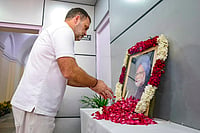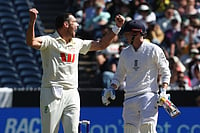It's finally here. And this time, it's for real—for it's both affordable and efficient. Although India was late in crossing this technology-milestone, it has arrived at the broadband frontier with the launch of new and faster services by both BSNL and MTNL last week. Says an exuberant IT minister, Dayanidhi Maran, "We've been slow to adopt new technologies in the television and internet spheres, but this will work in our favour."
State-owned BSNL's DataOne, MTNL's TriBand and private-sector Bharti's recent expansion will allow consumers in metros and large cities to access videos and TV channels on their computer screens. And, they can soon gear up for video conferencing, e-medicine and e-education. What will draw subscribers now are prices—they have been slashed by a minimum of 50 per cent, to Rs 500 a month and lower. Access speeds have improved to a minimum of 256 kbps or twice that of the earlier schemes. Says a senior BSNL official: "Most of the earlier services were slightly faster than dial-up." There was also a problem with the last-mile connection and slow downlink speeds often left subscribers with unpleasant surfing experiences. Now ADSL technology enables high speed internet access through the telephone line, but keeps the telephone line free.
Things are moving fast. BSNL has set a target of 198 cities in the current year. Says N.K. Mangla, director, commercial, BSNL: "We will go to all places where our landlines exist. We will extend the service to all district headquarters by '06 and to all taluka headquarters by '07." The telecom ministry feels the psus can woo 10 million broadband users by '07. Going by the initial response, they could reach there ahead of time. While BSNL claims to have registered over 50,000 users at launch, there is already a waiting list at MTNL counters. Now, that's ominous for private players.
Think about it. BSNL has a presence in 4,500 cities where it already has operational copper cables which is ready to port broadband services. Even Reliance Infocomm with its extensive cable network in India is a long way behind and Bharti which has mobile presence in 21 telecom circles has broadband presence in just six states. BSNL also owns a nationwide backbone—the National Internet Backbone—that runs across the country. So, it can replicate in broadband what it did in mobile telephony. Despite being a late entrant in the latter area, it's shot to No. 2 position, with a subscriber base that's only a shade under Airtel's 10 million.
Expect a shakeout in the near future as experts feel that not many will be able to withstand the might of BSNL and MTNL. Agrees Jasjit Sawhney, CEO, Net4India, an internet service provider that has ventured into broadband in six cities: "The psus will always have an edge because they have the wires and the reach. Some policy issues need to be sorted out to provide a level playing field for private players." Adds Rajeev Kohli, CEO, Airtel Broadband and Internet Services: "We expected the local loop to be thrown open which could have given us some level playing field. That didn't happen. Now we're looking at our one million fixed line subscribers to sell broadband to, while they are looking at 40 million." The only snag: the advantage with psus of the last-mile presence will be negated by newer wireless technologies like Wi-Max, whose protocols may be cleared this July. But then, BSNL is preparing to get into that sphere too and will start a pliot project in the next two months.
All this augurs well for consumers since the government has targeted 20 million subscribers by 2010. Says Mangla: "With the current small base, broadband population should grow by at least 100 per cent for the next three years after which there may be at least 50-60 per cent growth.We should comfortably touch 9-10 million by '07." Adds Sawhney: "Till now, broadband was limited to the metros and larger cities. With BSNL coming into the fray, we could see exponential growth in smaller cities."
What could however dent Mangla's dreams is the country's low PC penetration; of the 40 million telephone subscribers of BSNL and MTNL, less than 25 per cent own a PC. Moreover, India's internet subscriber base is under five million and broadband penetration is estimated at just two per 10,000, which may not change soon given the rural IT demographics. According to market estimates, 70 per cent of India's broadband market and demand is in Delhi and Bombay. The bulk of BSNL's subscribers is in rural areas and do not need high-speed internet. Agrees Kohli: "We still have a demand for low speeds and most of it is from non-sophisticated users. Unless this changes, growth patterns cannot change."
Add to that the lack of content and applications; both BSNL and MTNL are yet to finalise providers for content as well as other high-end value-added services. Says Mangla: "At this moment, we are giving just high-speed internet but in two months time value-added services will roll out. We are getting representations from both domestic and foreign companies for content which will be finalised soon." But will prices crash further?
Private operators feel the high cost of international bandwidth is a primary obstacle in lowering prices. Expensive customer premises equipment (CPE) also keep costs high. At present, operators are subsidising their CPEs to woo subscribers who pay between Rs 99 and Rs 250 a month or a one-time charge of around Rs 1,200-1,500 for the equipment which costs over Rs 2,000. But if the tariff trends in mobile telephony are an indicator, broadband users are in for some exciting times ahead.
256 kbps @ Rs 500
BSNL and MTNL shake up the market. Good news for customers, bad for rivals.

256 kbps @ Rs 500
256 kbps @ Rs 500
Published At:
MOST POPULAR
WATCH
MORE FROM THE AUTHOR
×

















